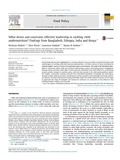| dc.contributor.author | Nisbett, Nicholas | |
| dc.contributor.author | Wach, Elise | |
| dc.contributor.author | Haddad, Lawrence | |
| dc.contributor.author | El Arifeen, Shams | |
| dc.coverage.spatial | Bangladesh | en |
| dc.coverage.spatial | Ethiopia | en |
| dc.coverage.spatial | India | en |
| dc.coverage.spatial | Kenya | en |
| dc.date.accessioned | 2018-05-10T09:28:09Z | |
| dc.date.available | 2018-05-10T09:28:09Z | |
| dc.date.issued | 2015-04-20 | |
| dc.identifier.citation | Nisbett, N., Wach, E., Haddad, L., El Arifeen, S. (2015) What Drives and Constrains Effective Leadership in Tackling Child Undernutrition? Findings from Bangladesh, Ethiopia, India and Kenya. Food Policy. Vol 53, pp. 33-55. | en |
| dc.identifier.issn | 0306-9192 | |
| dc.identifier.uri | https://opendocs.ids.ac.uk/opendocs/handle/20.500.12413/13736 | |
| dc.description | • Interviews with 89 leaders in four countries shed light on the incentives and constraints to effective leadership.
• Understanding leadership entails studying the adaptive practice of leaders rather than their personalities.
• Leaders studied operate within fluid boundaries set by local political-economies of nutrition.
• Successful leaders (high adult development levels) are able to span boundaries and translate between disciplines and sectors.
• Supportive action can develop leadership attributes in individuals and their networks in a number of ways identified here. | en |
| dc.description.abstract | Strong leadership has been highlighted as a common element of success within countries that have made rapid progress in tackling child and maternal undernutrition. Yet little is known of what contributes to nutrition leaders’ success or lack of it in particular policy environments. This study of 89 individuals identified as influential within child and maternal undernutrition policy and programming in Bangladesh, Ethiopia, Kenya and India sheds light on why particular individuals have been effective in contributing towards positive changes in nutrition policy, and how they operate in the wider policy/political sphere. We employ a framework working outwards from individual capabilities, knowledge and motivations, through to wider political economy considerations and the narratives and knowledge structuring individual capacity. We argue that only by locating individuals within this wider political economy can we begin to appreciate the range of strategies and avenues for influence (or constraints to that influence) that individual leaders employ and encounter. | en |
| dc.language.iso | en | en |
| dc.publisher | Elsevier | en |
| dc.rights | Copyright © 2015 The Authors. Published by Elsevier Ltd. | en |
| dc.rights.uri | http://creativecommons.org/licenses/by-nc-nd/4.0/ | en |
| dc.subject | Children and Youth | en |
| dc.subject | Development Policy | en |
| dc.subject | Health | en |
| dc.subject | Nutrition | en |
| dc.title | What Drives and Constrains Effective Leadership in Tackling Child Undernutrition? Findings from Bangladesh, Ethiopia, India and Kenya | en |
| dc.type | Article | en |
| dc.rights.holder | The authors | en |
| dc.identifier.externaluri | https://www.sciencedirect.com/science/article/pii/S030691921500038X | en |
| dc.identifier.team | Health and Nutrition | en |
| dc.identifier.doi | http://dx.doi.org/10.1016/j.foodpol.2015.04.001 | |
| dcterms.dateAccepted | 2015-04-01 | |
| rioxxterms.funder | Default funder | en |
| rioxxterms.identifier.project | Default project | en |
| rioxxterms.version | VoR | en |
| rioxxterms.versionofrecord | https://doi.org/10.1016/j.foodpol.2015.04.001 | en |
| rioxxterms.funder.project | 9ce4e4dc-26e9-4d78-96e9-15e4dcac0642 | en |


